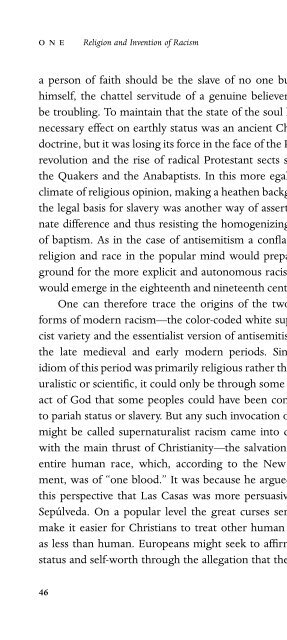Racism - A Short History - George M Fredrickson.pdf - WNLibrary
Racism - A Short History - George M Fredrickson.pdf - WNLibrary
Racism - A Short History - George M Fredrickson.pdf - WNLibrary
Create successful ePaper yourself
Turn your PDF publications into a flip-book with our unique Google optimized e-Paper software.
THREE Climax and Retreat<br />
occupied a highly advantaged position at the expense of<br />
indigenous populations in all of the European colonies in<br />
Africa, Asia, and the Pacific. But effective domination and<br />
a modicum of respect for the professed ideal of a “civilizing<br />
mission” normally required exceptions to the color line for<br />
native elites that had either assimilated the culture of the<br />
colonizing power (as in French and Portuguese possessions)<br />
or were allowed to maintain a measure of their precolonial<br />
authority under the systems of indirect rule favored especially<br />
by the British. 4 It appears that the only early-twentieth-century<br />
imperial power that officially banned intermarriage<br />
between colonists and nonwhites, including those of<br />
mixed blood, was Germany (a fact that will prove relevant<br />
to our subsequent discussion of the origins of Nazi racism).<br />
Latin American societies with significant black or Indian<br />
populations discriminated informally against those<br />
who were not white or European (i.e., branco, blanco, or<br />
ladino), but did not pass Jim Crow laws or ban intermarriages,<br />
which occurred with relative frequency. In such societies,<br />
ideologies sanctioning or even glorifying race mixture<br />
could in fact serve as an apparently nonracist facade for<br />
the persistence of great social and economic disparities that<br />
correlated roughly with differences in phenotype. 5 Despite<br />
all the de facto discrimination and negative stereotyping<br />
that prevailed in the northern United States between Reconstruction<br />
and the 1950s, it did not have an overtly racist<br />
regime. Many states tolerated intermarriage, and public<br />
facilities remained, insofar as the law was concerned, unsegregated.<br />
The historian <strong>George</strong> Reid Andrews contrasted<br />
the unofficial racism of the American North and Brazil with<br />
the “crudeness and visibility” of white supremacy in the<br />
102
















